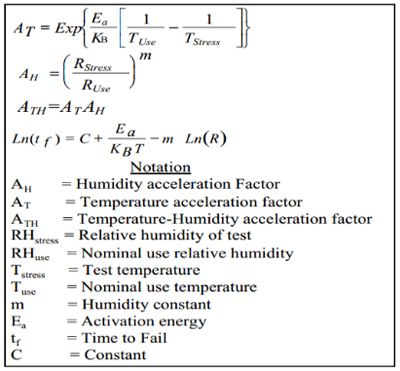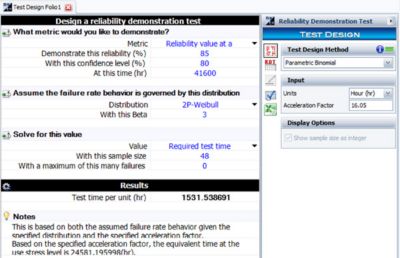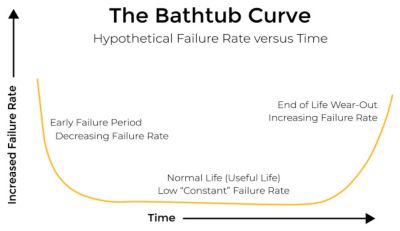Ansys 部落格
April 2, 2020
透過加速壽命測試(ALT)預測電子零件故障
什麼是加速壽命測試?
加速壽命測試 (ALT) 是一種快速且具成本效益的解決方案,用以判斷電子產品或元件的可靠度與堅固性。
ALT 能在比實際使用環境更短的時間內揭露潛在故障風險,並量化產品或元件的壽命特性,進而改善產品設計並加速上市時間。
產品可靠度對成功至關重要,
尤其是像印刷電路板 (PCB) 這類電子產品
為了比實際使用情境施加更大的應力並更快引發損壞,ALT 模擬產品在現實世界中可能遭遇的環境條件,例如:
- 衝擊與振動
- 熱變化
- 濕度
- 關機後再開機
若想瞭解如何推動與實施這些測試規範,請觀看網路研討會:測試計畫制定──加速因子與壽命預測。
什麼是加速因子?
加速因子 (AF) 是實際使用時間與測試時間之比,用於特定故障機制,是設計有效加速壽命測試以進行壽命預測時的關鍵要素。
AF:加速因子
Tfield:實際使用時間
Tt:測試時間
加速壽命測試的類型
ALT 分為兩種類型:
- 定性
- 定量
工程師只利用定性 ALT 來揭示故障模式與機制。例如,定性測試包含:
- 高加速壽命測試 (HALT)
- 高加速應力篩選 (HASS)
- 極限測試
- 振動與高溫測試
這些測試的目的在於發現常見故障模式或設計缺陷,藉此提升產品品質與可靠度。如果裝置能存活下來,即代表通過了定性測試。此外,定性測試也能提供定量加速測試所需之應力類型與等級的參考依據。
定量 ALT 可在特定可靠度與可信度水準下,量化電子元件的壽命特性。透過加速模型可將施加的應力與故障時間建立關聯。例如,常見的應力測試包括:
- 熱循環測試 (TC)
- 熱溼度偏差測試 (THB)
- 高溫老化
- 機械循環
THB 測試的
加速模型範例
除了進行 ALT 以進行現場壽命預測外,亦可針對印刷電路板組裝 (PCBA) 進行特定的電路板階可靠度測試 (BLRT),以評估半導體封裝在焊接到印刷電路板 (PCB) 上後的穩健性。這些測試可能屬於定性或定量性質,取決於具體測試類型,並有助於在設計與製造流程中確保組裝可靠度 。
深入瞭解 BLRT 的重要性,請參閱《成功進行電路板層級可靠度測試的 6 個步驟》白皮書。
加速類型
測試中的加速方式可分為:
- 使用率加速
- 高應力加速
使用率加速是提升施加於被測器件 (DUT) 上的應力頻率,但應力本身仍與實際環境中所承受者相同。只要頻率增加的幅度在測試中仍屬合理,即不會對 DUT 施加額外應力。
例如,工程師可透過每 10 秒開關一次微波爐門進行測試,直到達到實際使用預期的開關次數。此開關頻率遠高於商用環境中的預期頻率,但施加於門上的力量仍與實際使用情況相同。由於實際使用時的負載週期較低,相較於測試中可達到的高頻率循環,因此可以在幾小時或幾天內完成測試,而非需時數年。若 DUT 在實際使用環境中具有更高的負載週期 (接近持續運作),則可在測試中達成的加速效果會受到限制。
高應力加速則是將施加於裝置的應力提升至超出其在實際環境中會經歷的水準。此處使用「高應力」而非「過應力」,是因為後者可能暗示超出裝置設計極限,這並非所期望的測試情況。使用高應力加速時,不建議將裝置應力施加至誘發其在實際環境中不會發生的故障機制。
例如,在高溫與低溫環境下操作戶外燈開關,並在測試中超出最極端的溫度條件 (例如接近美國亞利桑那州鳳凰城的環境條件),只要測試溫度仍在該開關的設計極限範圍內,即可視為適當測試。因此,測試中應根據裝置的規格與材料特性考慮其設計極限,以限制施加的應力水準。
測試中所施加的應力水準應維持在設計
與材料特性的上下限之內
壽命預測設定
一旦 ALT 搭配加速因子 (AF) 實施後,會有多個參數影響壽命預測所需的測試時間。這些參數包括:
- 實際使用壽命 (包含負載週期)
- 可靠度因子 (例如 90% 可靠度)
壽命預測設定的參數
- 可信度水準因子 (例如 80% 的可信度)
- 所採用的加速因子
- 假設的可靠度分佈
- 測試中的樣本數量
加速因子 (AF) 取決於所關注的故障機制 (例如熱機械應力、熱老化等),並進一步決定所使用的加速模型類型。所選模型應與其對應參數 (例如活化能、應力水準等) 具相關性。
浴缸曲線
一種常見且具彈性的可靠度分佈為二參數威布爾及其相關的 beta 值 (β)。此 β 值可根據歷史故障資料 (由時間或循環次數至失效的圖形計算得出),或根據典型浴缸曲線中預期的故障模式進行推估。通常,對於磨損型故障機制,β 會大於 1:
- β<1 代表早期故障階段
- β=1 代表恆定的故障率 (隨機故障)
- β>1 代表磨損型故障
根據這些參數,可使用標準的可靠度軟體工具來判定:
- 為達到所需測試時間所需的測試樣本數 (n),或
- 在既定可靠度、可信度水準因子以及測試樣本數的條件下,達到現場目標壽命所需的測試時間
壽命預測分析
一旦確定並執行了 ALT 的測試計畫,就可以對結果進行分析。如果沒有發生故障,則可視為該裝置與所關注的故障機制已符合所需的可靠度與可信度指標。若發生故障,最佳情況是有數筆故障紀錄,這樣才能進行更精確的統計分析並推估預期壽命。若想進一步瞭解加速因子 (AF) 及加速壽命測試 (ALT),請觀看網路研討會:測試計畫制定──加速因子與壽命預測。





